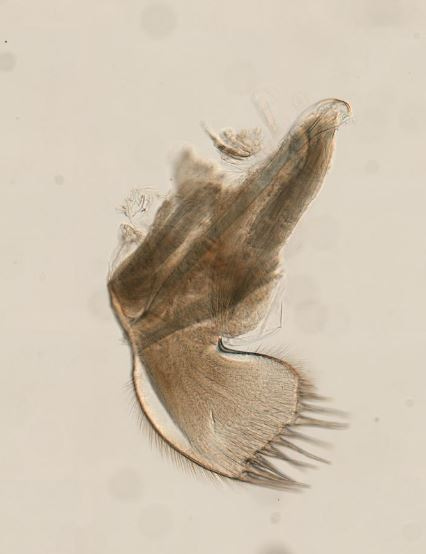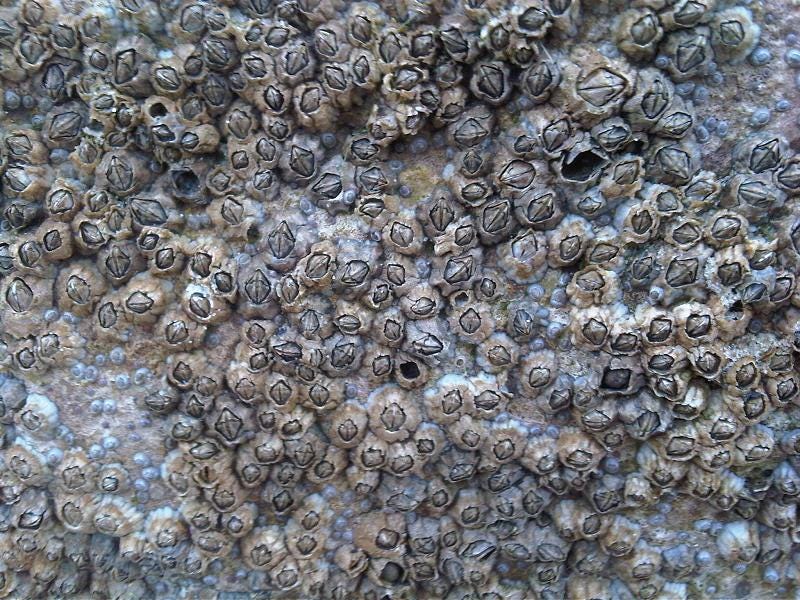Life on the Ledge: Unveiling Barnacles
Imogen examines this commonly overlooked seashore creature
Barnacles may not be the first creatures that spring to mind when we think about marine biodiversity. However, these small, seemingly inconspicuous organisms hold a world of fascination for me. As part of the Crustacea class, barnacles are more closely related to crabs and lobsters than to the mussels and clams to which they appear similar. In this blog - let’s take a look at a creature which is familiar to anyone who has walked along the coast, but often little understood - a look into the life of barnacles.

So what exactly are barnacles?
Barnacles are sessile arthropods. In their adult form they are found attached to hard surfaces in marine environments all around the world, from shallow tidal waters to oil rigs in the middle of the ocean and they vary significantly in size and shape. They are best known by the hard, calcareous plates that encase them, offering protection against many predators and environmental challenges.
There are well over 1,000 known species of barnacles with more being discovered all the time. Along our own UK coastline, a variety of barnacle species thrive, flourishing in the intertidal zones where the North Atlantic's cold nutrient-rich waters meet the land.
The most commonly encountered species and most easily recognisable is the acorn barnacle (Semibalanus balanoides), which forms dense, white-encrusted colonies on rocks, providing a very distinctive aspect to the coastal scenery. Often cutting the feet of unsuspecting beachgoers.
Engineering Survival
Barnacles have a fascinating adaptation that allows them to survive out of water during low tides. These marine organisms are encased in a shell composed of multiple plates that fit tightly together. When the tide retreats, barnacles close their plates, which interlock perfectly to form a nearly watertight seal. Inside their shells, they have trapped a bubble of seawater. This retained water serves to keep the barnacle moist, which is crucial for its survival out of water.
Once submerged the twin pairs of shell-like valves in the centre gradually open - and the delicate, feathery structures called cirri emerge to assist the acorn barnacle feed. They move in a rhythmic pattern efficiently capturing minuscule organisms from the water, which they then kick back into the barnacle’s hidden mouth.
Complex Life cycle
The lifecycle of barnacles is nothing short of remarkable, involving a dramatic metamorphosis from a free-swimming larval stage to a sedentary adult life. Darwin drew parallels with that of the butterfly metamorphosis.
Barnacles are hermaphrodites, possessing both male and female reproductive organs, which allows for self-fertilization in some species. However, most barnacle species prefer cross-fertilization, extending their long retractable penises (the longest in the animal kingdom) to reach neighbouring barnacles . This unique reproductive strategy ensures genetic diversity and increases the chances of successful reproduction. An interesting piece of trivia is that the penis of the acorn barnacle only lasts for one season and is then discarded, the barnacle will grow a new one the following year!
Barnacle larvae are known as nauplii, they hatch from eggs, that have been ejected from the adult after fertilization. These larvae are free floating and roam around the ocean, often able to cover some distances. They undergo several larval stages, during which time they feed on plankton.
As they mature, they transform into a cyprid stage, equipped with special antennae to explore potential surfaces for attachment. At this point in the life cycle they have a mere 2 weeks to find a suitable surface on which to land. Once found, the cyprid cements itself headfirst onto the surface, undergoing a final metamorphosis into the adult form. It concentrates minerals (calcium) from the ocean depositing them to create the hard casing we land mammals are familiar with seeing, and associate with barnacles.
As they grow, barnacles continue to secrete new calcareous plates to enlarge their shells, accommodating their increasing size. This process is analogous to a snail growing its shell, albeit with the barnacle's body fixed in position.
Ecological Role and Importance
Barnacles play a crucial role in marine ecosystems. They serve as a food source for a variety of predators, including birds, fish, and starfish. Their ability to adapt and attach to various surface types, including rocks, ship hulls, plastic buoys and even whales, has notable ecological and economic impacts. On the one hand, barnacles contribute to biofouling and also lead to increased drag on ships and higher fuel consumption. On the other hand, barnacles act as ecosystem engineers, creating habitats for other organisms.
Their presence benefits the marine mammals by removing parasites and attracting other species to the location where they reside. The intricate structure the barnacle colony provides, offers shelter and surfaces for a range of marine species, contributing to the biodiversity of marine communities.
Barnacles may often be overlooked, yet they are among the most intriguing and important organisms in the marine world. Their complex lifecycles, unique reproductive strategies, and ecological role make them a fascinating subject for study. Charles Darwin spent innumerable hours in this endeavour and by all accounts became very frustrated as a result saying in the Origin of Species:
By understanding and appreciating the significance of barnacles, we may better comprehend the intricate web of life that thrives beneath the waves in our inter-tidal zones.
So…when you next find yourself by the sea, seek out a small item coated with barnacles and place it in a container filled with seawater.
Then watch to see the magic underwater life of the barnacle unfold before your very eyes.
Imogen Furlong, the High Life Highland Countryside Ranger Manager, is known for her enthusiasm, organisation, and drive. Her deep passion for the Scottish Highlands' wildlife and extensive experience in outdoor education and recreation management have been central to this role. Imogen is a practical and collaborative project manager, empowering her teams to work effectively in communities and contribute to local conservation efforts.








Fascinating! Thankyou 😊